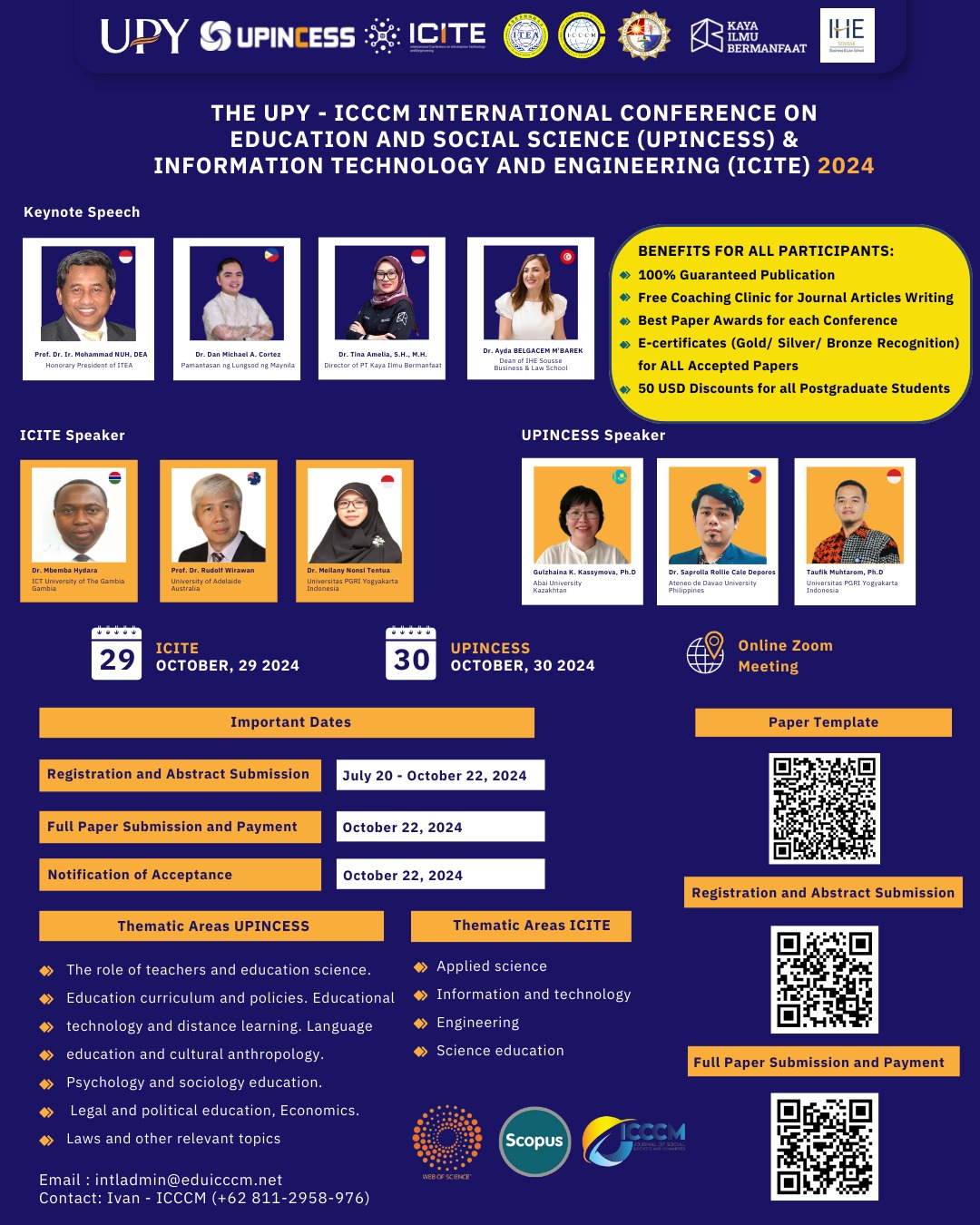The Relationship Between Language Acquisition and Theory of Social Interactionist
DOI:
https://doi.org/10.53797/icccmjssh.v1i4.9.2022Keywords:
Language, Language Acquisition, Theory of Social Interactionist, Environmental InfluenceAbstract
Language is one of the mediums used in the process of communication among people. An articulation device that makes sounds to form a meaning or something of speech that can be understood by the people around. This process of language acquisition that takes place can illustrate that the occurrence of developmental processes on one of the important functions of the human body. This is because, along with the physical growth of a child, their language development also develops naturally. This process of language acquisition occurs in children's brains when they acquire their first language, the native language. Fundamentally, this theory of language acquisition from a psycholinguistic point of view was pioneered by several famous figures such as Skinner (Behaviorist), Chomsky (Nativist), Piaget (Cognitive) and Vygotsky (Social Constructivist). However, researchers will focus this paper on the paradigm of language acquisition using the theory of Social Interactionist) which is fundamentally based on Vygotsky. The Theory of Social Interactionist assumes that environmental factors and experiences gained through social interaction are contributing to the child's language acquisition. With support from an interactive environment, children will be able to improve their language achievement and knowledge to a higher level. The process of interaction between parents and children can also help them strengthen the child's knowledge. The child's language acquisition process will also develop to the maximum when there is a process of positive interaction and relationships established in the family environment, peers, and the environment at school. In conclusion, a constructive environment and positive social interaction in the environment that surrounds children will help them further improve their language abilities.
Downloads
References
Asmah Omar.(1986). Bahasadan Perkembangan Mental. Jurnal Dewan Bahasa .31(10), 711-720
Asmah Omar (1996). Wacana Perbincangan, Perbahasan dan Perundingan. Kuala Lumpur. Dewan Bahasa dan Pustaka.
Che Nidzam Che Ahmad, Saidatul Ainoor Shaharim, & Asmayati Yahaya. (2016). Kesesuaian Persekitaran Pembelajaran, Interaksi Guru-Pelajar,Komitmen Belajar dan Keselesaan Pembelajaran dalam Kalangan Pelajar Biologi. Jurnal Pendidikan Sains & Matematik Malaysia, 6(1), 101–120.
Chomsky, N. (1957). Syntactic Structure. The Hague: Mouton.
Chomsky, N. (1968). Language and Mind. Harcourt: Brace and World New York. Confrey, J. (1995). A theory of intelectual development (part 3), For the Learning of Mathematics. 15(2), 36–45.
Fatimah Endang. (2006). Psikologi Perkembangan (Perkembangan Peserta Didik). Bandung: Penerbit CV Pustaka Setia. Forrester, M. A. (1992). The development of young children's social-cognitive skills. Lawrence Erlbaum Associates, Inc.
Mahn, H., & John-Steiner, V. (2012). Vygotsky and Sociocultural Approaches to Teaching and Learning. In Handbook of Psychology, Second Edition. https://doi.org/http://dx.doi.org/10.1002/9781118133880.hop207006
Mahzan Arshad. (2012). Lisan dan Tulisan: Teks dan Budaya. Kuala Lumpur. Dewan Bahasa dan Pustaka.
Mamluatul Hasanah. (2011). Model Nativis Language Acquisition Device (sebuah teori pemerolehan bahasa). Lingua: Jurnal Ilmu Bahasa dan Sastra. 1, 35-49.
Mangantar Simanjuntak. (1987). Pengantar Psikolinguistik Moden. Kuala Lumpur: Dewan Bahasa dan Pustaka. Mansoor, F., & Mohammad Amerian, I. (2015). First Language Acquisition: Revisiting the Social Interactionist
Paradigm. Humanising Language Teaching, 17(3), 1–6.
Mohamad Rozi Kasim. (2021). Sejauhmanakah Kaedah Bacaan di Malaysia Mencapai Aras Aplikasi dalam Taksonomi Bloom? Malaysian Journal of Social Sciences and Humanities (MJSSH), 6(1), 12–26. http://dx.doi.org/10.47405/mjssh.v6i1.592
Muhamad Aizat Md Nasir. (2016). Kesan Penggunaan Kartun Melalui Persekitaran Pembelajaran Maya terhadap Prestasi, Motivasi dan Interaksi Sosial dalam kalangan Pelajar Ekonomi Asas. In (Tesis Sarjana yang tidak diterbitkan). Universiti Pendidikan Sultan Idris, Tanjong Malim, Malaysia.
Muradi, A. (2018). Pemerolehan Bahasa Dalam Perspektif Psikolinguistik Dan Alquran. Jurnal Tarbiyah : Jurnal Ilmiah Kependidikan, 7(2), 145–162. https://doi.org/10.18592/tarbiyah.v7i2.2245
Nor Hashimah Jalaluddin. (1999). Relevens, Komunikasi dan Kognisi (Terjemahan). Kuala Lumpur. Dewan Bahasa dan Pustaka.
Noor Adzli Ishak. (2011). Pemerolehan semantik gramatikal dalam kalangan murid-murid prasekolah. (Tesis Sarjana yang tidak diterbitkan), Universiti Putra Malaysia, Serdang, Malaysia.
Nur Nadirah Zukeflli, & Subramaniam, V. (2018). Paralinguistik dalam Pemerolehan Bahasa Kanak-Kanak. International Journal of Language Education and Applied Linguistics, 8(1), 1–13. http://ijleal.ump.edu.my.
Ormrod, J.E. (2007). Educational Psychology: Developing Learners (6th edition). New York: Prentice Hall. Poedjiadi, A. (1999). Pengantar Filsafat Ilmu bagi Pendidik. Bandung: Penerbit Yayasan Cendrawasih
Prasetya. (2003). Pola asuh otoriter pada anak. (Tesis Ijazah Sarjana yang tidak diterbitkan),Universitas Gunadanna, Jakarta, Indonesia.
Rohayati Junaidi, Tengku Intan Marlina Tengku Mohd Ali, & Madiawati Mamat @ Mustaffa. (2018). Mesosistem Dalam
Novel Kanak-Kanak Terpilih. Jurnal Pengajian Melayu, 29(1), 181–200. https://doi.org/10.22452/jomas.vol29no1.8 Saeparno, N. A. (2015). Pola Asuhan dalam Pemerolehan Bahasa Kanak-kanak Tadika Bandar Palembang Indonesia. In (Tesis PhD yang tidak diterbitkan). Universiti Pendidikan Sultan Idris, Tanjong Malim, Malaysia.
Sufriadi, H. (2016). Pengaruh Keluarga dalam Meningkatkan Kecerdasan Emosi dan Pencapaian Akademik dalam Kalangan Pelajar Madrasah di Aceh. In (Tesis Sarjana yang tidak diterbitkan). Universiti Pendidikan Sultan Idris, Tanjong Malim.
Tay, M. G. (2006). Pemerolehan Bahasa Kanak-kanak: Satu Analisis Sintaksis. Jurnal Penyelidikan IPBL, 7, 87–108. Tudge, J., & Rogoff, B. (1989). Peer influences on cognitive development: piagetian and vygotskian perspectives. In M.
H. Bornstein & J. S. Bruner (Eds.), Interaction in Human Development (17–40). Lawrence Erlbaum Associates, Inc. Utami, I. G. A. L. P. (2016). Teori Konstruktivisme dan Teori Sosiokultural: Aplikasi dalam Pengajaran Bahasa Inggris.Prasi, 11(01), 4–11.
Van Der Veer, R. (1999). Lev S. Vygotsky. Handbook of Pragmatics, XXIV(3), 1–15. https://doi.org/10.1075/hop.3.vyg1 Yohanes, R. S. (2010). Teori Vygotsky dan Implikasinya terhadap Pembelajaran Matematika. Widya Warta, 02, 127–135.
Zalikha Mat Saad, & Normahdiah Syeik Said. (2015). Konsep Makna Kata dalam Kalangan Kanak-kanak Berdasarkan Lakaran Visual 2D dan 3D Terpilih. International Journal of Language Education and Applied Linguistics (IJLEAL), 02, 61–73.
Downloads
Published
How to Cite
Issue
Section
License
Copyright (c) 2022 Norsahirah Ghani, Abdul Rasid Jamian, Norfaizah Abdul Jobar

This work is licensed under a Creative Commons Attribution-NonCommercial-ShareAlike 4.0 International License.




